An Expert Explains How To Make The Ultimate Omurice Omelet
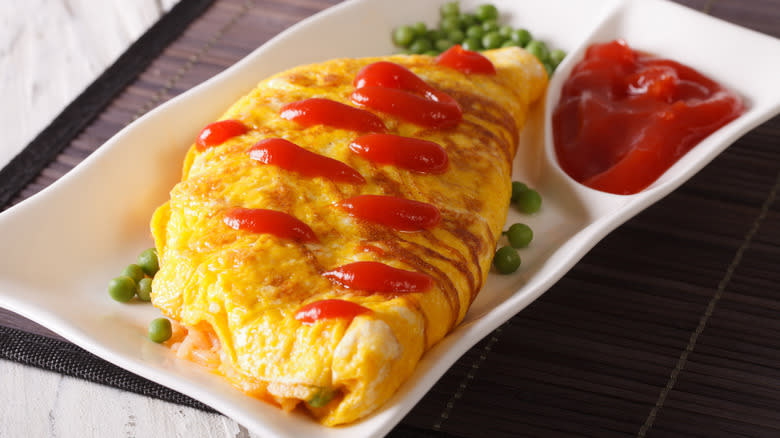
If you want an easy way to make eggs part of dinner, a dish called omurice might be a good pick. This meal hails from Japan and is essentially an omelet wrapped around a pile of ketchup-infused fried rice or chicken fried rice. It's often served with ketchup adorning it as well. There are two different styles of the dish: split-style -- called fuwatoro omurice -- and classic. The former has a runny texture, and the omelet is served on top of the rice. The latter, however, is fluffy and is served by packing the rice inside the omelet.
If you've never made this dish before but are interested in trying it, Namiko Hirasawa Chen (otherwise known as Nami), the creator behind the Japanese recipe blog Just One Cookbook, spoke with Daily Meal and provided some exclusive insights into how you can make the best omurice possible, regardless of which style you want to try.
Nami says that the type of pan you use and the heat settings are crucial to getting a well-cooked and well-presented meal. She also says you'll need to pay close attention to the omelet's texture. She explains, "For a classic-style omurice, you want a custardy and creamy texture. For a split-style omurice ... the texture is more fluid and runny, so you don't cook it as long. The cooking technique for both is similar."
Read more: French Cooking Tricks You Need In Your Life
Set Yourself Up For Success
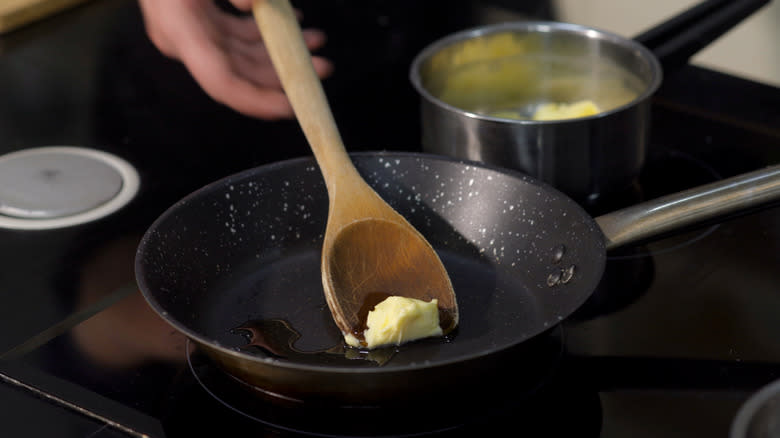
To make a great omurice, preparation is key, which includes choosing a suitable pan and selecting the ideal temperature. Namiko Hirasawa Chen recommends an 8-inch nonstick pan with sloped edges: "A pan bigger than 8 inches will make folding and flipping extremely difficult to handle, as you will need more rice to fill such a big omelet." Plus, the sloped sides will make it easier to flip and fold your meal.
Even though Nami recommends a nonstick pan, you'll still want to grease it. With what, Nami says, is up to you, although she comments, "I'd say butter is a nice choice as the chicken rice or ketchup rice has a slightly acidic flavor, and butter adds a nice rich, creamy texture and flavor that adds extra depth to the dish." Still, you could forgo the richness with margarine, or use olive oil for fruity or bitter notes.
With your pan in hand, switch on the stove and get ready to get started. Nami recommends using a medium heat setting throughout the cooking process. Even then, she says, if the pan gets too hot, you can lift it away from the heat for a few seconds to prevent too much browning. Remember, your meal should have a consistent pale yellow color. She also suggests moving your pan to a wet cloth to cool it after you've mastered the omelet and added the chicken rice to it to help further prevent browning.
Pay Attention To The Texture Of Your Eggs
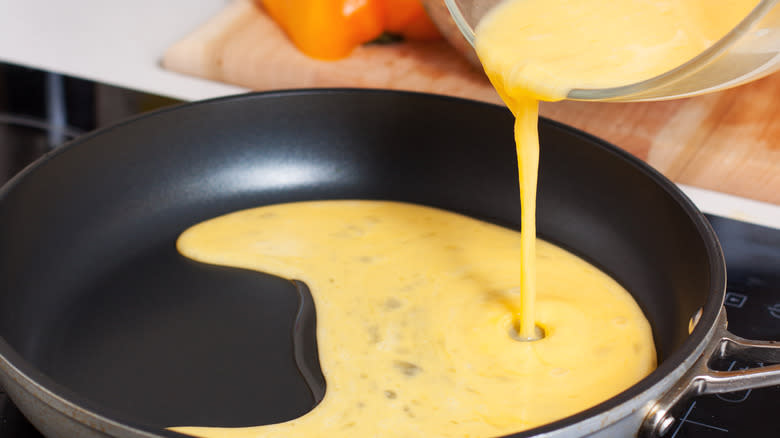
To get started cooking omurice, Namiko Hirasawa Chen says that you'll need to "pour the egg mixture into the pan and stir the eggs quickly in a spiral motion with chopsticks while you shake the pan." She says that the key here is to maintain movement; this helps create a smooth outer surface and fluffy curds in your eggs. She notes, "I found that chopsticks can create really nice small curds better than a silicone spatula."
You'll want to keep stirring the eggs until they've adopted the right consistency. Nami explains, "For a classic-style omurice, stop stirring when the eggs are half-cooked and the egg curds look creamy, soft-scrambled, and custardy." This will give you a soft, fluffy omelet that will hold up to stuffing it with rice. On the other hand, she says, "For a split-style omurice, stop stirring the eggs sooner, when they have coagulated somewhat but are still fluid and runny; then let the bottom set for several seconds." This texture lets the eggs run down over your rice, sort of like a sauce, when you serve them.
Finesse The Fold
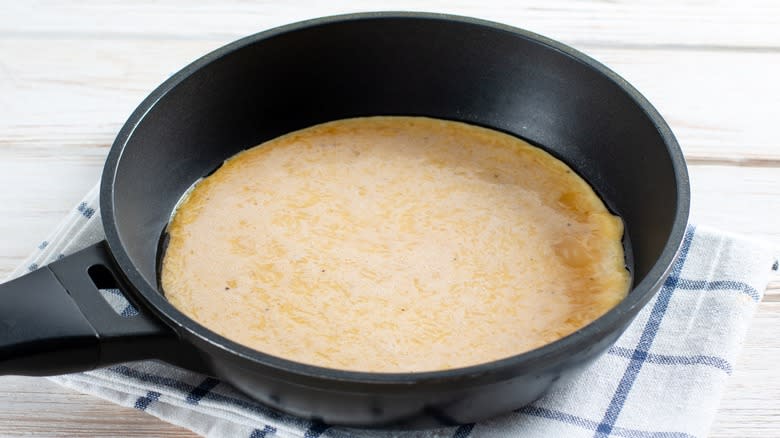
Folding and flipping are parts of making omurice that can be tricky for first-timers, and if you don't get them right it can get messy. Namiko Hirasawa Chen explains that you'll need to adjust your folding technique depending on what kind of omelet you're making.
For a classic-style, she recommends pre-portioning and shaping your chicken to save time and maintain the egg's texture. Then, add them to the middle of the omelet in the pan. Nami advises using a spatula to shape the omelet from front to back. Finish by moving the meal to the edge of the pan and quickly flipping it onto a plate. If it's not quite the shape you were going for, she offers a quick solution: "Cover it with a sheet of paper towel and fix the shape with your hands for a nice presentation."
If it's a split-style you're making, Nami says to use a spatula after the egg sets on the bottom. Then, she advises, "Tilt the pan forward as you roll up the half of the omelet closest to you onto the other half. Then, hit down the handle with your free hand as you flip up the pan several times to roll the far side of the omelet onto itself (use the spatula to help it along)." Finish up by turning the omelet over and cooking it for another 10 seconds. Then, lay it atop your rice and cut it in the center.
Add Some Flair To Your Sauces
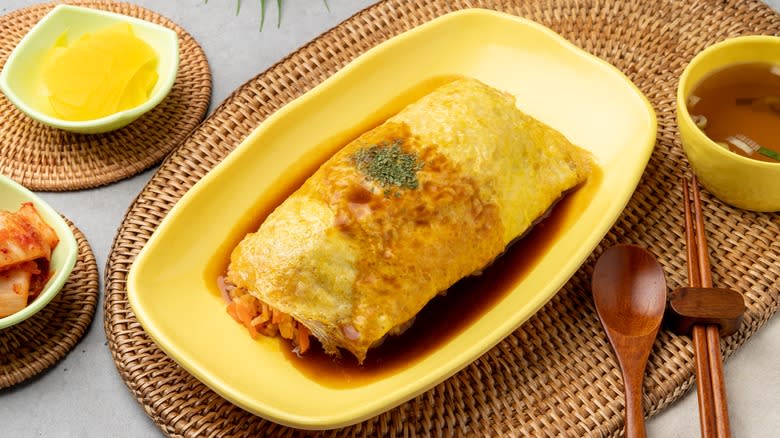
Ketchup is traditionally used to make omurice, both in the rice itself and as a final garnish, and Namiko Hirasawa Chen says that for a truly authentic experience, KAGOME (a Japanese ketchup brand) is the way to go: "It's made only with wholesome ingredients without any color or preservatives. I'd say for many Japanese people, the omurice's nostalgic taste comes from this." However, you could use any brand you want.
You can also have fun and get creative with your ketchup. A few suggestions she offers include mixing in Worcestershire sauce or sauce for tonkatsu, which is another traditional Japanese food. Another option might be to add some spice and stir in a bit of wasabi. It's up to you to experiment with flavors!
Nami mentions that you can always move away from ketchup entirely. For instance, you could use a demi-glace sauce, Japanese hamburger steak and sauce, hayashi rice sauce, a bechamel-style sauce, or curry sauce. The sky's the limit when it comes to your options for adding your own personal flair to this dish while still enjoying a bite of traditional Japanese cuisine.
Read the original article on Daily Meal

